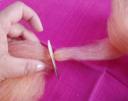I dove into the batt from Abby’s September batt club offering. She provided a 2 oz. batt of luscious superfine merino/tussah/suri alpaca/mongolian cashmere blend in a beautiful orange that she called “Harvest Moon” and 2 oz. of tussah dyed to match Sorry, I have no before pictures of the batt. I just dove right in late last night and didn’t think about taking pictures until I finished 2 strips of the batt.
Today, I thought that I’d share with you on how I prepared the batt for spinning in a photo-tutorial. This is a picture laden post, so I’m putting it below the fold, so to speak. Proceed if you are interested.
This process requires both hands, so it’s a bit difficult to photograph. Please click on the thumbnails for larger pictures.
 I stripped the batt into 6 strips, along where there were natural breaks from where Abby pulled the batt off of the drum carder. The strips were still too large for the way I wanted to spin this, so I will be pulling the strips through a diz.
I stripped the batt into 6 strips, along where there were natural breaks from where Abby pulled the batt off of the drum carder. The strips were still too large for the way I wanted to spin this, so I will be pulling the strips through a diz.
Most people are familiar with using the diz to pull top off of combs, but they can also be used with batts to create roving.
Additional equipment required: a diz and a small crochet hook.
 Pull a small strand out of the strip and elongate it. You will be feeding this through one of the holes in the diz, so this will need to be a fairly small strand about 3″ long. I generally twirl this strand in my hand to ensure that it stays together as I pull it through.
Pull a small strand out of the strip and elongate it. You will be feeding this through one of the holes in the diz, so this will need to be a fairly small strand about 3″ long. I generally twirl this strand in my hand to ensure that it stays together as I pull it through.
 Use the crochet hook to pull the strand through one of the holes in the diz, with the concave side facing the fiber that you want to pull from.
Use the crochet hook to pull the strand through one of the holes in the diz, with the concave side facing the fiber that you want to pull from.
This diz has 4 different sizes of holes. I’m using medium large for this project. (This is a Celtic Knot diz made in Mother of Pearl from VIP Fibers. I bought it from Carolina Homespun.)
 I am working left to right. The left side is the strip of fiber that has not yet been pulled through the diz. The right side is the finished side.
I am working left to right. The left side is the strip of fiber that has not yet been pulled through the diz. The right side is the finished side.
Push the diz up against the strip as far as you can without forcing it. It will feel a bit like a jam, and you can’t pull anymore. You’ll see that the right side is pretty puffy. Much larger than the hole that you pull the fiber through. That is because the fiber was compressed when you pulled it through, and puffed up again with air after it was pulled through.
 With your hands on either side of the diz, gently attenuate the fiber on the left (unprocessed side). You want to use really light pressure. Don’t tug too hard, or you may break the strip.
With your hands on either side of the diz, gently attenuate the fiber on the left (unprocessed side). You want to use really light pressure. Don’t tug too hard, or you may break the strip.
 Push the diz gently along the newly attenuated fiber until it jams up against the remaining fiber.
Push the diz gently along the newly attenuated fiber until it jams up against the remaining fiber.
Repeat the above steps until you have finished pulling the entire strip through the diz.
 Here’s what happened when I lost concentration and tugged too hard. I came really close to breaking the roving when I was buzzed and scolded by a hummingbird for letting his feeding station get waterlogged in the deluge we had over the weekend.
Here’s what happened when I lost concentration and tugged too hard. I came really close to breaking the roving when I was buzzed and scolded by a hummingbird for letting his feeding station get waterlogged in the deluge we had over the weekend.
See how thin the spot became?
Intermission

This greedy little b*@!#, uh, bird, had to be assuaged before I was allowed to finish. He alternated between sitting on a nearby tree branch and the clothes line to chirp at me until I refilled his feeder with fresh nectar.
Yes, here’s a picture of an unprocessed strip (left) next to a processed roving (right).
You can do all this without the aid of a diz, but I find that the diz helps me create a more even roving, and helps realign the carded fiber.
 Here are the finished roving nests, ready to spin!
Here are the finished roving nests, ready to spin!
Fiber prepared this way is a breeze to spin. You can spin it either with short forward draw, American long draw, or anything in between.

